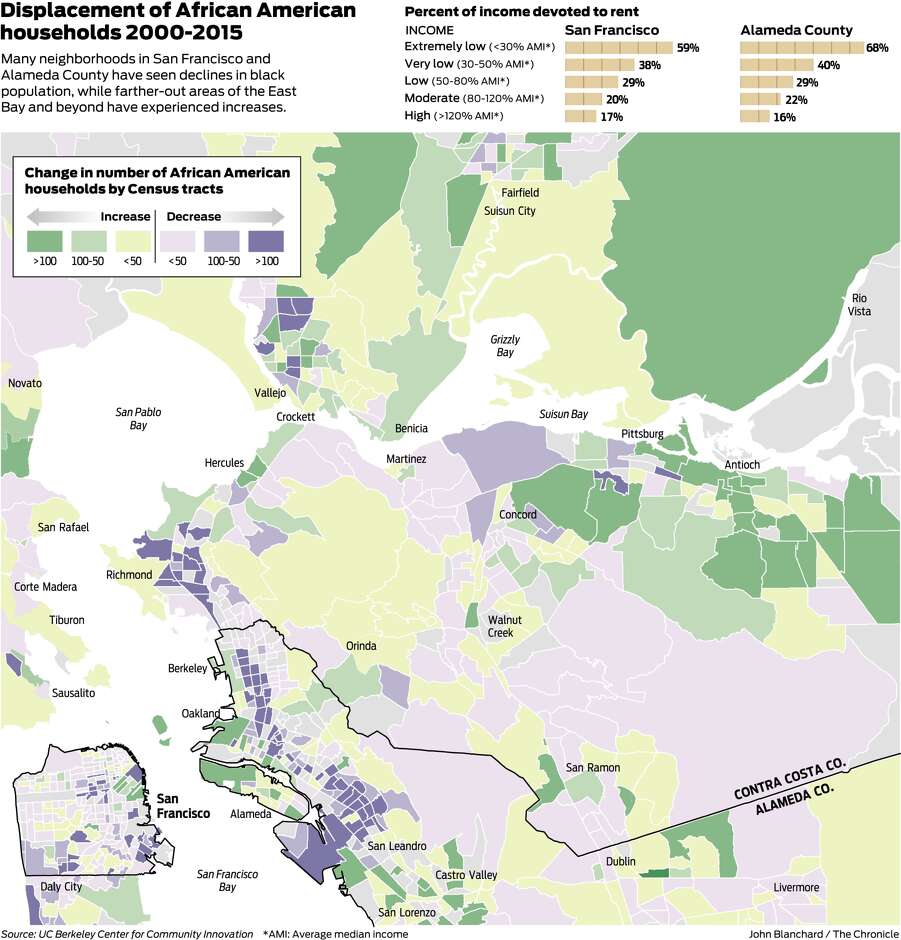The Bay Area’s soaring housing costs are pushing poor people into neighborhoods where poverty and racial segregation are on the rise, a UC Berkeley study published Wednesday found.
As a result, the region’s low-income families — particularly minority families — are increasingly cut off from relatives, their children may face worse health outcomes and parents’ commutes to work can dramatically lengthen.
UC Berkeley researchers tracked migratory patterns and demographic changes across the region from 2000 to 2015. They found that movements caused by housing costs are intensifying racial disparities among neighborhoods.

Many neighborhoods in San Francisco, Oakland, Berkeley and Richmond saw declines in black population while farther-out areas of the East Bay and beyond saw increases. Neighborhoods such as San Francisco’s Bayview and Oakland’s flatlands lost thousands of low-income black households; places like unincorporated Cherryland in Alameda County and eastern Contra Costa County saw influxes.
Neighborhoods with low pollution, high-quality schools and other resources have become increasingly inaccessible for African Americans, according to the report. The study was a project by UC Berkeley’s Urban Displacement Project and the California Housing Partnership, a nonprofit that advocates expanding affordable housing.
https://ethanburrell.github.io/CCI_Movement_Map/Final_to_send/Rent_Demographics_map.html
Interactive Map by: Ethan Burrell and Eva Phillips
“The housing market today is operating in the context of an architecture of segregation and vulnerability that was baked into cities and regions over a period of many decades,” said Dan Rinzler, a senior policy analyst with the group. “It’s more or less moving the pieces around to the detriment of people of color and low-income communities.”
For instance, by 2015 in San Francisco, a low-income white family was three times more likely to live in a high-resource area than a moderate- or high-income black family, the research found. In Alameda County, low-income white households were seven times more likely to live in such a neighborhood compared to a wealthier black family. And in Contra Costa County, a low-income white family was 14 times more likely to live in a better-off neighborhood than a black family with moderate or high income.
“The disparities were shocking in some cases,” Rinzler said.
Miriam Zuk, director of the Urban Displacement Project, said the research was undertaken to look at granular, neighborhood-level changes. She said it was also important to break out various racial groups, rather than compare all people of color to white people.
“We talk about the reshuffling of people in spaces as if there are no consequences,” Zuk said. “There’s this trope of, ‘Oh, everyone is free to move where they want and maybe moving from a low-income area of the city to the suburbs is a good thing.’ What we see is that’s not happening. When people move, they are not necessarily moving to better-off places.”
Families that moved needed to use a higher share of their income to pay rent in their new home, the study found.
The analysis showed that across the Bay Area, a 30 percent increase in median rent in a given neighborhood corresponded with a more than 20 percent decrease in the number of low-income African Americans, Latinos, and Asians living there. The researchers found no significant relationship between rent increases and losses of low-income white households.
In three counties studied in the most detail — San Francisco, Alameda and Contra Costa — the researchers found “significant and uneven shifts” between 2000 and 2015 in the neighborhoods where low-income people of color lived. Demographic changes at the city level could be pinpointed to just a few neighborhoods where they were the most concentrated.
The Longfellow neighborhood in North Oakland, for instance, lost 400 low-income black households — more than any other in Alameda County — between 2000 and 2015, according to the study. Three East Oakland ZIP codes whose low-income Latino populations increased in that period saw the highest rates of child lead poisoning in the county.
In San Francisco, although the low-income Asian and Latino populations grew on an aggregate level, they decreased in historical cultural hubs such as Chinatown and the Mission.
The researchers found that Contra Costa County households that moved in 2015 tended to stay within the county, while those displaced from San Francisco usually settled somewhere else in the Bay Area.
But a large proportion of low-income families that moved out of their Alameda County homes left the region altogether: Black families often went to Stockton and areas of Contra Costa County, while Latino families primarily went to Tracy, San Jose and cities in San Mateo County, and Asian families typically went to parts of Santa Clara and Solano counties.
No comments:
Post a Comment